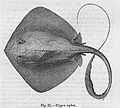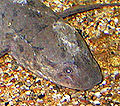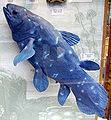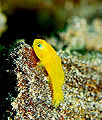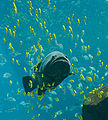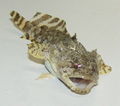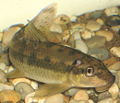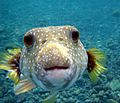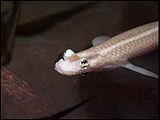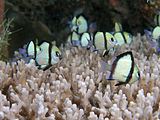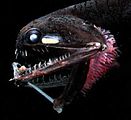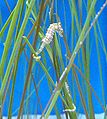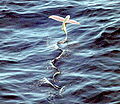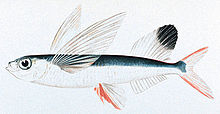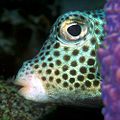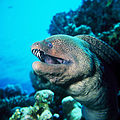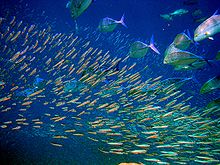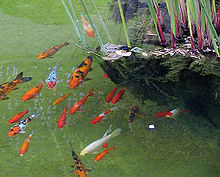- Diversity of fish
-
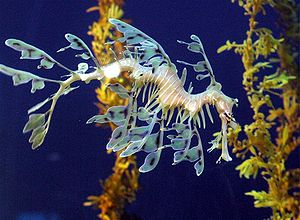 Fish come in many shapes and sizes. This is a sea dragon, a close relative of the seahorse. They are camouflaged to look like floating seaweed.[1][2][3]
Fish come in many shapes and sizes. This is a sea dragon, a close relative of the seahorse. They are camouflaged to look like floating seaweed.[1][2][3]
Fish are very diverse and are categorized in many ways. This article is an overview of some of the more common types of fish. Although most fish species have probably been discovered and described, about 250 new ones are still discovered every year. According to FishBase, 32,100 species of fish had been described by September 2011.[4] That is more than the combined total of all other vertebrates: mammals, amphibians, reptiles and birds.
Contents
By species
fishes jawless cartilaginous bony lobe finned ray finned Basic taxonomy of fishes Fish systematics is the formal description and organisation of fish taxa into systems. It is complex and still evolving. Controversies over "arcane, but important, details of classification are still quietly raging."[5]
The term "fish" describes any non-tetrapod chordate, (i.e., an animal with a backbone), that has gills throughout life and has limbs, if any, in the shape of fins.[6] Unlike groupings such as birds or mammals, fish are not a single clade but a paraphyletic collection of taxa, including jawless, cartilaginous and skeletal types.[7][8]
Jawless fish
Jawless fish are the most primitive fish. There is current debate over whether these are really fish at all. They have no jaw, no scales, no paired fins, and no bony skeleton. Their skin is smooth and soft to the touch, and they are very flexible. Instead of a jaw, they possess an oral sucker. They use this to fasten on to other fish, and then use their rasp-like teeth to grind through their host's skin into the viscera. Jawless fish inhabit both fresh and salt water environments. Some are anadromous, moving between both fresh and salt water habitats.
Extant jawless fish are either lamprey or hagfish. Juvenile lamprey feed by sucking up mud containing micro-organisms and organic debris. The lamprey has well-developed eyes, while the hagfish has only primitive eyespots. The hagfish coats itself and carcasses it finds with noxious slime to deter predators, and periodically ties itself into a knot to scrape the slime off. It is the only invertebrate fish and the only animal which has a skull but no vertebral column.[9] It has four hearts, two brains, and a paddle-like tail.[10]
-
Lampreys attached to a lake trout
-
Mouth of a sea lamprey
-
Pacific hagfish resting on bottom at 280 m
Cartilaginous fish
Cartilaginous fish have a cartilaginous skeleton. However, their ancestors were bony animals, and were the first fish to develop paired fins. Cartilaginous fish don't have swim bladders. Their skin is covered in placoid scales (dermal denticles) that are as rough as sandpaper. Because cartilaginous fish do not have bone marrow, the spleen and special tissue around the gonads produces red blood cells. Their tails can be asymmetric, with the upper lobe longer than the lower lobe. Some cartilaginous fishes possess an organ called Leydig's Organ which also produces red blood cells.
There are over 980 species of cartilaginous fish. They include sharks, rays and chimaera.
-
This elephant fish is a chimaera
Bony fish
Bony fish include the lobe finned fish and the ray finned fish. The lobe finned fish is the class of fleshy finned fishes, consisting of lungfish, and coelacanths. They are bony fish with fleshy, lobed paired fins, which are joined to the body by a single bone.[11] These fins evolved into the legs of the first tetrapod land vertebrates, amphibians. Ray finned fishes are so-called because they possess lepidotrichia or "fin rays", their fins being webs of skin supported by bony or horny spines ("rays").
There are three types of ray finned fishes: the chondrosteans, holosteans, and teleosts. The chondrosteans and holosteans are primitive fishes sharing a mixture of characteristics of teleosts and sharks. In comparison with the other chondrosteans, the holosteans are closer to the teleosts and further from sharks.
-
Lungfish can breathe in air as well as water
-
Model of a coelacanth, thought until 1938 to be extinct. They are deep blue.
-
This Atlantic sturgeon is a chondrostean
Teleosts
Teleosts are the most advanced or "modern" fishes. They are overwhelmingly the dominant class of fishes (or for that matter, vertebrates) with nearly 30,000 species, covering about 96 percent of all extant fish species. They are ubiquitous throughout fresh water and marine environments from the deep sea to the highest mountain streams. Included are nearly all the important commercial and recreational fishes.[12]
Teleosts have a movable maxilla and premaxilla and corresponding modifications in the jaw musculature. These modifications make it possible for teleosts to protrude their jaws outwards from the mouth.[13][14] The caudal fin is homocercal, meaning the upper and lower lobes are about equal in size. The spine ends at the caudal peduncle, distinguishing this group from those in which the spine extends into the upper lobe of the caudal fin.[13]
By size
 External images
External images
Photo of the world's smallest fish The smallest species is Paedocypris progenetica, a type of minnow. It is also the smallest vertebrate. The smallest mature female had a standard length of 7.9 mm (0.31 in). The largest individual is 10.3 mm (0.41 in). They live in the dark–colored peat swamps of the Indonesian island of Sumatra.[15][16][17]
Other contenders for smallest fish are the male anglerfish, Photocorynus spiniceps,[18] and the stout infantfish, a type of goby.[19] According to the Guinness Book of World Records, the sinarapan, another type of goby, is the world's smallest commercially harvested fish.[20] Found in the Philippines, they have an average length of 12.5 mm (0.49 in), and are threatened by overfishing.[17]
The largest is the whale shark. It is a slow moving filter feeding shark with a maximum published length of 20 m (66 ft) and a maximum weight of 34 tonnes. Whale sharks can live up to 70 years.[21]
The heaviest bony fish is the ocean sunfish. It can weigh up to 2,300 kg (5,100 lb). It is found in all warm and temperate oceans.[22] The longest bony fish is the king of herrings. Its total length can reach 11 m (36 ft), and it can weigh up to 272 kilograms (600 lb). It is a rarely seen oarfish found in all the world's oceans, at depths of between 20 m (66 ft) and 1,000 m (3,300 ft).[23]
-
Some of the smallest fishes are minnow-type fishes, including the smallest of all, Paedocypris progenetica.
-
The whale shark is the largest living fish (human shown for comparison)
-
The ocean sunfish is the heaviest bony fish
-
The king of herrings is the longest bony fish
By life span
Some of the shortest-lived species are gobies, which are small coral reef–dwelling fish. Some of the longest-lived are rockfish.
The shortest lived is the seven-figure pygmy goby, which lives for at most 59 days. This is the shortest lifespan for any vertebrate.[24] Short lived fish have particular value in genetic studies on aging. In particular, the ram cichlid is used in laboratory studies because of its ease of breeding and predictable aging pattern.[25][26]
The longest–lived fish is the 205 years reported for the rougheye rockfish, Sebastes aleutianus, found offshore in the North Pacific at 25–900 metres (14–490 fathoms). This fish exhibits negligible senescence.[27][28][29]
There are stories about Japanese Koi goldfish passed from generation to generation for 300 years. Scientists are sceptical. Counting growth lines on the scales of fish confined to ponds or bowls is unreliable, since they lay down extra lines.[30][31] The maximum reliably reported age for a goldfish is 41 years[32]
The longest living commercial fish may be the orange roughy, with a maximum reported age of 149 years.[33] One of the longest living sport fish is the Atlantic tarpon, with a maximum reported age of 55 years."[34][35][36]
Some of the longest living fish are living fossils, such as the green sturgeon. This species is among the longest living species found in freshwater, with a maximum reported age of 60 years. They are also among the largest fish species found in freshwater, with a maximum reported length of 2.5 meters (8.2 ft) and a maximum reported weight of {{kg to lb}159}}.[37][38][39] Another living fossil is the Australian lungfish. One individual has lived in an aquarium for 75 years, and is the oldest fish in captivity. According to fossil records, the Australian lungfish has hardly changed for 380 million years.[40][41][42]
-
Among gobies, small coral reef-dwelling fish, are some of the shortest lived fishes with the seven-figure pygmy goby living at most for 59 days.
-
Among rockfish are some of the longest living fishes with the rougheye rockfish living for 205 years.
-
The orange roughy may be the longest lived commercial fish, at 149 years[43]
By habitat
See also: Marine habitatsThere is 10,000 times more saltwater in the oceans than there is freshwater in the lakes and rivers. However, only 58 percent of extant fish species are saltwater. A disproportionate 41 percent are freshwater fish (the remaining one percent are anadromous).[44] This diversity in freshwater species is, perhaps, not surprising, since the thousands of separate lake habitats promote speciation.[45]
Habitat Area Volume Depth Species Fish biomass million km2 million cu km (mean) count percent million tonnes Saltwater 361[46] 1370.8[47] 3.8 km 18,000 58[44] 800-2,000[48] Freshwater 1.5[49] 0.13[50] 87 m 13,000 41[44] Fish can also be demersal or pelagic. Demersal fish live on or near the bottom of oceans and lakes, while pelagic fish inhabit the water column away from the bottom. Habitats can also be vertically stratified. Epipelagic fish occupy sunlit waters down to 200 metres (110 fathoms), mesopelagic fish occupying deeper twilight waters down to 1,000 meters (3,300 ft), and bathypelagic fish inhabiting the cold and pitch black depths below.
Most oceanic species (78 percent, or 44 percent of all fish species), live near the shoreline. These coastal fish live on or above the relatively shallow continental shelf. Only 13 percent of all fish species live in the open ocean, off the shelf. Of these, 1 percent are epipelagic, 5 percent are pelagic, and 7 percent are deep water.[44]
Fish are found in nearly all natural aquatic environments.[51] Most fish, whether by species count or abundance, live in warmer environments with relatively stable temperatures.[45] However, some species survive temperatures up to 44.6 °C (112.3 °F), while others cope with colder waters; there are over 200 finfish species south of the Antarctic Convergence.[52] Some fish species tolerate salinities over 10 percent.[51] The world's deepest living fish, Abyssobrotula galatheae, a species of cusk eel, lives in the Puerto Rico Trench at a depth of 8,372 meters (27,467 ft).[51][53] At the other extreme, the Tibetan stone loach lives at altitudes over 5,200 meters (17,100 ft) in the Himalayas.[51][54]
Some marine pelagic fish range over vast areas, such as the blue shark that lives in all oceans. At the other extreme are fish confined to single, small living spaces, such as isolated cave fish like Lucifuga in the Bahamas and Cuba,[55] or equally isolated desert pupfish living in small desert spring systems in Mexico and the southwest U.S., or bythitid vent fish like Thermichthys hollisi, living around thermal vents 2,400 metres (1,300 fathoms) down.[51][56]
-
The blue shark ranges across all oceans
By breeding behavior
See also: SpawningGrouper are protogynous hermaphrodites, who school in harems of three to fifteen females. When no male is available, the most aggressive and largest females shift sex to male, probably as a result of behavioral triggers.
In very deep waters, it is not easy for a fish to find a mate. There is no light, so some species depend on bioluminescence. Others are hermaphrodites, which doubles their chances of producing both eggs and sperm when an encounter does occur.[57] The female anglerfish releases pheromones to attract tiny males. When a male finds her, he bites on to her and never lets go. When a male of the anglerfish species Haplophryne mollis bites into the skin of a female, he release an enzyme that digests the skin of his mouth and her body, fusing the pair to the point where the two circulatory systems join up. The male then atrophies into nothing more than a pair of gonads. This extreme sexual dimorphism ensures that, when the female is ready to spawn, she has a mate immediately available.[58]
Some sharks, such as hammerheads[59] are able to breed parthogenetically.
-
Female groupers change their sex to male if no male is available.
-
Female Haplophryne mollis anglerfish trailing atrophied males she encountered.[63]
By brooding behavior
See also: SpawningFish adopt a variety of strategies for nurturing their brood. Sharks, for example, variously follow three protocols with their brood. Most sharks, including lamniformes[64] are ovoviviparous, bearing their young after they nourish themselves after hatching and before birth, by consuming the remnants of the yolk and other available nutrients. Some such as hammerheads[65] are viviparous, bearing their young after nourishing hatchlings internally, analgously to mammalian gestation. Finally catsharks[66] and others are, oviparous, laying their eggs to hatch in the water.
Some animals, predominantly fish such as cardinalfish[67] practice mouthbrooding, caring for their offspring by holding them in the mouth of a parent for extended periods of time. Mouthbrooding has evolved independently in several different families of fish.
Others, such as seahorse[68] males, practice pouch-brooding, analogous to Australia's kangaroos, nourishing their offspring in a pouch in which the female lays them.
-
A female Cyphotilapia frontosa mouthbrooding fry which can be seen looking out her mouth
-
The chain catshark is oviparous, laying its eggs to hatch in the water.
-
The great white shark is ovoviviparous, gestating eggs in the uterus for 11 months before giving birth.
-
The scalloped hammerhead is viviparous, bearing its young after nourishing hatchlings internally
By feeding behaviour
There are three basic methods by which food is gathered into the mouths of fish: by suction feeding, by ram feeding, and by manipulation or biting.[69] Nearly all fish species use one of these styles, and most use two.[70]
 External images
External images
Video of a slingjaw wrasse catching prey by protruding its jaw 
Video of a red bay snook catching prey by suction feeding Early fish lineages had inflexible jaws limited to little more than opening and closing. Modern telosts have evolved protusible jaws that can reach out to engulf prey.[71][72] An extreme example is the protusible jaw of the slingjaw wrasse. Its mouth extends into a tube half as long as its body, and with a strong suction it catches prey. The equipment tucks away under its body when it is not in use.[73][74]
In practice, feeding modes lie on a spectrum, with suction and ram feeding at the extremes. Many fish capture their prey using both suction pressure combined with a forward motion of the body or jaw.[75]
The cookiecutter shark is a small dogfish which derives its name from the way it removes small circular plugs, looking as though cut with a cookie cutter, from the flesh and skin of cetaceans and larger fish, including other sharks. The cookiecutter attaches to its larger prey with its suctorial lips, and then protrudes its teeth to remove a symmetrical scoop of flesh.[76]
-
A pomfret with bite wounds from a cookiecutter shark.
-
Striped bass eat smaller fish
-
Chinese algae eaters are kept in aquaria to control algae.
-
The Emperor angelfish feeds on coral sponges
Most fish are food opportunists, or generalists. They eat whatever is most easily available.[77] For example, the blue shark feeds on dead whales and nearly everything else that wriggles: other fish, cephalopods, gastropods, ascidians, crustaceans.[78][79] Ocean sunfish prefer jellyfish.[22]
-
Silver arowana leap two metres out of the water to capture prey.
-
Schooling herrings ram feed on copepods
-
The mangrove jack eats crustaceans
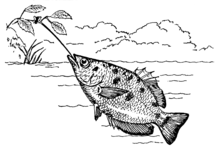 Archerfish shooting down an insect using a jet of water
Archerfish shooting down an insect using a jet of water
Other fish have developed extreme specializations. Silver arowana, also called monkey fish, can leap two meters out of the water to capture prey. They usually swim near the surface of the water waiting for potential prey. Their main diet consist of crustaceans, insects, smaller fishes and other animals that float on the water surface, for which its draw-bridge-like mouth is exclusively adapted for feeding. The remains of small birds, bats, and snakes have also been found in their stomachs.[80]
Archerfish prey on land–based insects and other small animals by literally shooting them down with water droplets from their specialized mouths. Archerfish are remarkably accurate; adults almost always hit the target on the first shot. They can bring down insects such as grasshoppers,[81] spiders and butterflies on a branch of an overhanging tree,[82] 3 m above the water's surface.[83] This is partially due to good eyesight, but also the ability to compensate for light refraction when aiming.[84] Triggerfish also use jets of water, to uncover sand dollars buried in sand or overturn sea urchins.[85]
-
Triggerfish use a jet of water to uncover sand dollars buried in sand.
-
The bucktoothed tetra eats scales off other fishes (lepidophagy)
-
These two small wrasses are cleaner fish, and eat parasites off other fish.
-
Doctor fish nibbling on the diseased skin of patients
Doctor fish (nibble fish) live and breed in the outdoor pools of some Turkish spas, where they feed on the skin of patients with psoriasis. The fish are like cleaner fish in that they only consume the affected and dead areas of the skin, leaving the healthy skin to recover.
By vision
Main article: Vision in fishesFour-eyed fish have eyes raised above the top of the head and divided in two different parts, so that they can see below and above the water surface at the same time. Four-eyed fish actually have only two eyes, but their eyes are specially adapted for their surface-dwelling lifestyle. The eyes are positioned on the top of the head, and the fish floats at the water surface with only the lower half of each eye underwater. The two halves are divided by a band of tissue and the eye has two pupils, connected by part of the iris. The upper half of the eye is adapted for vision in air, the lower half for vision in water.[86] The lens of the eye also changes in thickness top to bottom to account for the difference in the refractive indices of air versus water. These fish spend most of their time at the surface of the water. Their diet mostly consists of the terrestrial insects which are available at the surface.[87]
Many species of fish can see the ultraviolet end of the spectrum, beyond the violet.[88] The two stripe damselfish, Dascyllus reticulatus, has ultraviolet-reflecting colouration which they appear to use as an alarm signal to other fish of their species.[89] Predatory species cannot see this if their vision is not sensitive to ultraviolet. There is further evidence for this view that some fish use ultraviolet as a "high-fidelity secret communication channel hidden from predators", while yet other species use ultraviolet to make social or sexual signals.[90][91]
Mesopelagic fishes live in deeper waters, in the twilight zone down to depths of 1000 metres, where the amount of sunlight available is not sufficient to support photosynthesis. These fish are adapted for an active life under low light conditions. Barreleyes are a family of small, unusual-looking mesopelagic fishes, named for their barrel-shaped, tubular eyes which are generally directed upwards to detect the silhouettes of available prey.[92][93] Barreleyes have large, telescoping eyes which dominate and protrude from the skull. These eyes generally gaze upwards, but can also be swivelled forwards in some species. Their eyes have a large lens and a retina with an exceptional number of rod cells and a high density of rhodopsin (the "visual purple" pigment); there are no cone cells.[92] The barreleye species, Macropinna microstoma, has a transparent protective dome over the top of its head, somewhat like the dome over an airplane cockpit, through which the lenses of its eyes can be seen. The dome is tough and flexible, and presumably protects the eyes from the nematocysts (stinging cells) of the siphonophores from which it is believed the barreleye steals food.[92][94][93]
-
The four-eyed fish feeds at the surface of the water with eyes that allow it to see both above and below the surface at the same time
-
The two stripe damselfish can signal secret alarms by reflecting ultraviolet to other fish of its species
-
The barreleye has barrel-shaped, telescopic eyes which are
generally directed upwards, but can also be swiveled forward -
Flashlight fish use a retroreflector behind the retina with photophores to detect eyeshine in other fish.
Another mesopelagic fish is the flashlight fish. For more sensitive vision in low light, this fish has a retroreflector behind the retina. They also have photophores, which they use in combination with their retroreflector to detect eyeshine in other fish.[95][96][97]
By locomotion
See also: Fish locomotionThe slowest-moving fishes are the sea horses. The slowest of these, the dwarf seahorse, attains about five feet per hour.[98]
Among the fasted sprinters are the Indo-Pacific sailfish and the black marlin. Both have been recorded in a burst at over 110 kilometres per hour (68 mph). For the sailfish, that is equivalent to 12 to 15 times their own length per second. The wahoo is perhaps the fastest fish for its size, attaining a speed of 19 lengths per second, reaching 78 kilometres per hour (48 mph).
The shortfin mako shark is fast enough and agile enough to chase down and kill an adult swordfish, but they don't always win. Sometimes in the struggle with a shark a swordfish can kill it by ramming it in the gills or belly. The shortfin mako's speed has been recorded at 50 kilometres per hour (31 mph), and there are reports that it can achieve bursts of up to 74 kilometres per hour (46 mph).[99] It can jump up to 9 meters (30 ft) in the air. Due to its speed and agility, this high-leaping fish is sought as game worldwide. This shark is highly migratory. Its exothermic constitution partly accounts for its relatively great speed.[100]
The northern bluefin tuna is capable of sustained high speed cruising, and maintains high muscle temperatures so it can can cruise in arctic waters.
-
The slowest fishes are the seahorses, and the tiny dwarf seahorse is the slowest of all[98]
-
One of the fasted sprinters is the Indo-Pacific sailfish
-
The northern bluefin tuna is capable of sustained high speed cruising.
-
Flying fish taking off into a glide
A number of species jump while swimming near the surface, skimming the water. Flying fish have unusually large pectoral fins, which enable the fish to take short gliding flights above the surface of the water, in order to escape from predators. Their glides are typically around 50 meters (160 ft), but they can use updrafts at the leading edge of waves to cover distances of at least 400 meters (1,300 ft).[101] In May 2008, a flying fish was filmed off the coast of Japan (see video). The fish spent 45 seconds aloft, and was able to stay aloft by occasionally beating the surface of the water with its caudal (tail) fin.[102] The previous record was 42 seconds.[102]
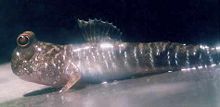 The mudskipper is a type of walking fish
The mudskipper is a type of walking fish
Walking fish are often amphibious and can travel over land for extended periods of time. Able to spend longer times out of water, these fish may use a number of means of locomotion, including springing, snake-like lateral undulation, and tripod-like walking. The mudskipper is probably the best land-adapted of contemporary fish and is able to spend days moving about out of water and can even climb mangroves, although to only modest heights.[103] There are some species of fish that can "walk" along the sea floor but not on land. One such animal is the flying gurnard, which can walk on the sea floor.
By toxicity
Toxic fish produce strong poisons in their bodies. Both poisonous fish and venomous fish, contain toxins, but deliver them differently.
Venomous fish bite, sting, or stab, causing an envenomation. Venomous fish don't necessarily cause poisoning if they are eaten, since the digestive system often destroys the venom. By contrast, the digestive system does not destroy poisonous fish toxins, making them poisonous to eat.[104]
The most poisonous fish is the puffer fish. It is the second most poisonous vertebrate after the golden dart frog. It paralyzes the diaphragm muscles of human victims, who can die from suffocation. In Japan, skilled chefs use parts of a closely related species, the blowfish to create a delicacy called "fugu", including just enough toxin for that "special flavour".
The spotted trunkfish is a reef fish which secretes a colourless ciguatera toxin from glands on its skin when touched. The toxin is only dangerous when ingested, so there's no immediate harm to divers. However, predators as large as nurse sharks can die as a result of eating a trunkfish.[105]
The giant moray is a reef fish at the top of the food chain. Like many other apex reef fish, it is likely to cause ciguatera poisoning if eaten.[106][107] Outbreaks of ciguatera poisoning in the 11th to 15th centuries from large, carnivorous reef fish, caused by harmful algal blooms, could be a reason why Polynesians migrated to Easter Island, New Zealand, and possibly Hawaii.[108][109]
-
The spotted trunkfish secretes a ciguatera toxin from glands on its skin
-
Like many other apex reef fish, the giant moray can cause ciguatera poisoning if eaten.
A 2006 study found that there are at least 1200 species of venomous fish.[110] There are more venomous fish than venomous snakes. In fact, there are more venomous fish than the combined total of all other venomous vertebrates.[110] Venomous fish are found in almost all habitats around the world, but mostly in tropical waters. They wound over 50,000 people every year.[111]
They carry their venom in venom glands and use various delivery systems, such as spines or sharp fins, barbs, spikes and fangs. Venomous fish tend to be either very visible, using flamboyant colors to warn enemies, or skilfully camouflaged and maybe buried in the sand. Apart from the defense or hunting value, venom help bottom dwelling fish by killing the bacteria that try to invade their skin. Few of these venoms have been studied. They are yet to be tapped resource for bioprospecting to find drugs with medical uses.[112]
The most venomous fish is the reef stonefish.[113][114] It has a remarkable ability to camouflage itself amongst rocks. It is an ambush predator that sits on the bottom waiting for prey to approach. Instead of swimming away if disturbed, it erects 13 venomous spines along its back. For defense, it can shoot venom from each or all of these spines. Each spine is like a hypodermic needle, delivering the venom from two sacs attached to the spine. The stonefish has control over whether to shoot its venom, and does so when provoked or frightened.[112] The venom results in severe pain, paralysis and tissue death, and can be fatal if not treated. Despite its formidable defenses, stonefish have predators. Some bottom feeding rays and sharks with crushing teeth feed on them, as does the Stokes' seasnake[117]
Unlike stonefish, lionfish[disambiguation needed
 ] can only release venom when something strikes its spines. Although not native to the U.S. coast, lionfish have appeared around Florida and have spread up the coast to New York. They are attractive aquarium fish, sometimes used to stock ponds, and may have been washed into the sea during a hurricane. Lionfish can aggressively dart at scuba divers and attempt to puncture their facemask with their venomous spines.[112]
] can only release venom when something strikes its spines. Although not native to the U.S. coast, lionfish have appeared around Florida and have spread up the coast to New York. They are attractive aquarium fish, sometimes used to stock ponds, and may have been washed into the sea during a hurricane. Lionfish can aggressively dart at scuba divers and attempt to puncture their facemask with their venomous spines.[112]The stargazer buries itself and can deliver electric shocks as well as venom. It is a delicacy in some cultures (cooking destroys the venom), and can be found for sale in some fish markets with the electric organ removed. They have been called "the meanest things in creation"[112]
Stingray envenomations can occur to people who wade in shallow water and tread on them. This can be avoided by shuffling through the sand or stamping on the bottom, as the rays detect this and swim away. The stinger usually breaks off in the wound. It is barbed, so it can easily penetrate but not so easily be removed. The stinger causes local trauma from the cut itself, pain and swelling from the venom, and possible later infection from bacteria. Occasionally severed arteries or death can result.[118]
Treatment for venom stings usually includes the application of heat, using water at temperatures of about 45 °C (113 °F), since heat breaks down most complex venom proteins.
By human use
Fish are sought by humans for their value as commercial food fish, recreational sport fish, decorative aquarium fish and in tourism, attracting snorkelers and SCUBA divers .
Throughout human history, important fisheries have been based on forage fish.[119] Forage fish are small fish which are eaten by larger predators. They usually school together for protection. Typical ocean forage fish feed near the bottom of the food chain on plankton, often by filter feeding. They include the family Clupeidae (herrings, sardines, menhaden, hilsa, shad and sprats), as well as anchovies, capelin and halfbeaks. Important herring fisheries have existed for centuries in the North Atlantic and the North Sea. Likewise, important traditional for anchovy and sardine fisheries have operated in the Pacific, the Mediterranean, and the southeast Atlantic.[120] The world annual catch of forage fish in recent years has been around 25 million tonnes, or one quarter of the world's total catch.
Higher in the food chain, Gadidae (cod, pollock, haddock, saithe, hake and whiting also support important fisheries. Concentrated initially in the North Sea, Atlantic cod was one of Europe's oldest fisheries, later extending to the Grand Banks,[121] Declining numbers led to international "cod wars" and eventually the virtual abandonment of these fisheries. These days the Alaska pollock supports an important fishery in the Bering Sea and the north Pacific, yielding about 6 million tonnes, while cod amounts to about 9 million tonnes.[120]
-
Yellowfin tuna are now being fished as a replacement for the depleted Southern bluefin tuna.
-
These schooling anchovy are forage fish
-
Atlantic cod fisheries have collapsed
Recreational and sport fishing is big business[122] U.S. saltwater fishers spend about $30 billion annually and support 350,000 jobs.[123] Some of the more popular recreational and sport fish include bass, marlin, porgie, shad, mahi-mahi, smelt whiting, swordfish, and walleye.
Fishkeeping is another popular pastime, and there is a large international trade for aquarium fish.
Snorkeling and SCUBA diving attract millions of people to beaches, coral reefs, lakes, and other water bodies to view fish and other marine life.
By vulnerability
Other types
Fish hold the records for the relative brain weights of vertebrates. Most vertebrate species have similar brain-to-body weight ratios. The deep sea bathopelagic cusk-eel Acanthonus armatus,[124] has the smallest ratio of all known vertebrates.[125] At the other extreme, the elephantnose fish, an African freshwater fish, has the largest ratio of all known vertebrates.[126]
Sarpa salpa, a species of bream are recognizable by the golden stripes running the length of its body and can induce LSD-like hallucinations if it is eaten.[127] These widely distributed coastal fish[128] became a recreational drug during the Roman Empire, and are called "the fish that make dreams" in Arabic. Other hallucinogenic fish are Siganus spinus,[129] called "the fish that inebriates" in Reunion Island, and Mulloidichthys samoensis,[130] called "the chief of ghosts" in Hawaii.[131]
Notes
- ^ Froese, Rainer, and Daniel Pauly, eds. (2009). "Phycodurus eques" in FishBase. July 2009 version.
- ^ Leafy and Weedy Sea Dragon National Geographic Profile. Retrieved 20 July 2009.
- ^ Connolly R (2006). Phycodurus eques. 2006. IUCN Red List of Threatened Species. IUCN 2006. www.iucnredlist.org. Retrieved on 20 July 2009.
- ^ FishBase: FishBase Retrieved 24 May 2011.
- ^ Moyle & Cech 2003, p. Chapter 1
- ^ Nelson, Joseph S. (2006). Fishes of the World. John Wiley & Sons, Inc.. p. 2. ISBN 0471250317.
- ^ Helfman, G.; Collette; Facey, D. (1997). The Diversity of Fishes, Blackwell Publishing. ISBN 0-86542-256-7.
- ^ Tree of life web project - Chordates.
- ^ N. A. Campbell and J. B. Reece (2005). Biology Seventh Edition. Benjamin Cummings, San Francisco CA.
- ^ Aird WC (2007) Endothelial biomedicine p. 67. Cambridge University Press. ISBN 9780521853767
- ^ Clack, J. A. (2002) Gaining Ground. Indiana University
- ^ Telost Encyclopædia Britannica Online. 15 July 2009
- ^ a b Benton, Michael J. (1990). Vertebrate Paleontology. London: Chapman & Hall. ISBN 0-412-54010-X.
- ^ Ben Waggoner (1995-07-17). "Telostei". Museum of Paleontology, University of California, Berkeley. http://www.ucmp.berkeley.edu/vertebrates/actinopterygii/teleostei.html. Retrieved 2006-06-08.
- ^ Kottelat M, Britz R, Tan HH and Witte KE (2005) "Paedocypris, a new genus of Southeast Asian cyprinid fish with a remarkable sexual dimorphism, comprises the world's smallest vertebrate" Proceedings of the Royal Society B 273 :895-899.
- ^ World's smallest fish 2006, Natural History Museum
- ^ a b Froese, Rainer, and Daniel Pauly, eds. (2009). "Paedocypris progenetica" in FishBase. July 2009 version.
- ^ Froese, Rainer, and Daniel Pauly, eds. (2009). "Photocorynus spiniceps" in FishBase. July 2009 version.
- ^ Froese, Rainer, and Daniel Pauly, eds. (2009). "Schindleria brevipinguis" in FishBase. July 2009 version.
- ^ Foot, T (2000) Guinness Book of World Records 2001. Guinness World Records Ltd.
- ^ Froese, Rainer, and Daniel Pauly, eds. (2009). "Rhincodon typus" in FishBase. July 2009 version.
- ^ a b Froese, Rainer, and Daniel Pauly, eds. (2009). "Mola mola" in FishBase. July 2009 version.
- ^ Froese, Rainer, and Daniel Pauly, eds. (2009). "Regalecus glesne" in FishBase. July 2009 version.
- ^ Depczynski M, Bellwood DR (2005) "Shortest recorded vertebrate lifespan found in a coral reef fish" Current Biology, 15 (8): R288-R289.
- ^ Herrera M and Jagadeeswaran P (2004) "Annual Fish as a Genetic Model for Aging" The Journals of Gerontology Series A: Biological Sciences and Medical Sciences 59:B101-B107.
- ^ Froese, Rainer, and Daniel Pauly, eds. (2009). "Cynolebias nigripinnis" in FishBase. July 2009 version.
- ^ Munk, K. (2001) "Maximum Ages of Groundfishes in Waters off Alaska and British Columbia and Considerations of Age Determination". Alaska Fishery Research Bulletin 8 :1.
- ^ Cailliet, G.M., Andrews, A.H., Burton, E.J., Watters, D.L., Kline, D.E., Ferry-Graham, L.A. (2001) "Age determination and validation studies of marine fishes: do deep-dwellers live longer?" Exp. Gerontol. 36 : 739–764.
- ^ Froese, Rainer, and Daniel Pauly, eds. (2009). "Sebastes aleutianus" in FishBase. July 2009 version.
- ^ How to Tell Time by a Cat's Eye
- ^ Froese, Rainer, and Daniel Pauly, eds. (2009). "Cyprinus carpio" in FishBase. July 2009 version.
- ^ Froese, Rainer, and Daniel Pauly, eds. (2009). "Carassius auratus" in FishBase. July 2009 version.
- ^ Froese, Rainer, and Daniel Pauly, eds. (2009). "Hoplostethus atlanticus" in FishBase. July 2009 version.
- ^ Night Tarpon Fishing Trips
- ^ Froese, Rainer, and Daniel Pauly, eds. (2009). "Megalops atlanticus" in FishBase. July 2009 version.
- ^ Froese, Rainer, and Daniel Pauly, eds. (2009). "Megalops cyprinoides" in FishBase. July 2009 version.
- ^ Protective Regulations Proposed for Ancient, Imperiled Southern Green Sturgeon
- ^ Contemporaries of the Dinosaurs, Sturgeon Fossils Date Back 200 Million Years
- ^ Sturgeons
- ^ The Oldest Living Fish
- ^ The Shedd Honors Its Oldest Residen
- ^ Froese, Rainer, and Daniel Pauly, eds. (2009). "Neoceratodus forsteri" in FishBase. July 2009 version.
- ^ Froese, Rainer, and Daniel Pauly, eds. (2009). "Hoplostethus atlanticus" in FishBase. May 2009 version.
- ^ a b c d Cohen DM (1970) "How many recent fishes are there?." Proceedings of the California Academy of Sciences, 38(17):341–346
- ^ a b Bone & Moore 2008, p. 3
- ^ CIA Factbook: World.
- ^ Elert, Glenn Volume of Earth's Oceans. The Physics Factbook. Retrieved 19 April 2008.
- ^ Wilson RW, Millero FJ, Taylor JR, Walsh PJ, Christensen V, Jennings S and Grosell M (2009) "Contribution of Fish to the Marine Inorganic Carbon Cycle" Science, 323 (5912) 359-362. (This article contains the first ever estimate of global fish biomass)
- ^ Shiklomanov, I A, (1993) World fresh water resources in Glick, P H, ed., Water in Crisis: Oxford University Press, p 13-24.
- ^ Horn, MH (1972) The amount of space available for marine and freshwater fishes NOAA: Fishery Bulletin 70, 1295-1297
- ^ a b c d e Bone & Moore 2008, p. 35
- ^ C.Michael Hogan. 2011. Ross Sea. Eds. P.Saundry & C.J.Cleveland. Encyclopedia of Earth. National Council for Science and the Environment. Washington DC
- ^ Froese, Rainer, and Daniel Pauly, eds. (2009). "Abyssobrotula galatheae" in FishBase. July 2009 version.
- ^ Froese, Rainer, and Daniel Pauly, eds. (2009). "Triplophysa stoliczkai" in FishBase. July 2009 version.
- ^ Froese, Rainer, and Daniel Pauly, eds. (2009). "Luifuga " in FishBase. July 2009 version.
- ^ Froese, Rainer, and Daniel Pauly, eds. (2009). "Thermichthys hollisi" in FishBase. July 2009 version.
- ^ Ryan P "Deep-sea creatures: The bathypelagic zone" Te Ara - the Encyclopedia of New Zealand. Updated 21 September 2007.
- ^ Theodore W. Pietsch. "Precocious sexual parasitism in the deep sea ceratioid anglerfish, Cryptopsaras couesi Gill". http://www.nature.com/nature/journal/v256/n5512/abs/256038a0.html. Retrieved 31 August 2009.
- ^ Froese, Rainer, and Daniel Pauly, eds. (2006). Species of Sphyrna in FishBase. April 2006 version.
- ^ Froese, Rainer, and Daniel Pauly, eds. (2009). "Batrachoididae" in FishBase. September 2009 version.
- ^ Froese, Rainer, and Daniel Pauly, eds. (2009). "Opsanus beta" in FishBase. September 2009 version.
- ^ Moyle & Cech 2003, p. 4
- ^ *Anglerfish Video
- ^ Froese, Rainer, and Daniel Pauly, eds. (2006). "Lamniforme" in FishBase. April 2006 version.
- ^ Froese, Rainer, and Daniel Pauly, eds. (2006). Species of Sphyrna in FishBase. April 2006 version.
- ^ Froese, Rainer, and Daniel Pauly, eds. (2006). "Scyliorhinidae" in FishBase. April 2006 version.
- ^ Froese, Rainer, and Daniel Pauly, eds. (2006). "Apogonidae" in FishBase. April 2006 version.
- ^ Froese, Rainer, and Daniel Pauly, eds. (2006). Species of Hippocampus in FishBase. April 2006 version.
- ^ Liem KF (1980) "Adaptive Significance of Intra- and Interspecific Differences in the Feeding Repertoires of Cichlid Fishes" American Zoologist, 20 (1):295-314.
- ^ Bone & Moore 2008, p. 92
- ^ Liem KF (1980) "Acquisition of energy by teleosts: adaptive mechanisms and evolutionary patterns". In Environmental Physiology of Fishes (Ed. M A Ali), pp. 299–334. New York, London: Plenum Press.
- ^ Lauder GV (1980) "Evolution of the feeding mechanism in primitive actinopterygian fishes: a functional anatomical analysis of Polypterus, Lepisosteus and Amia". J. Morphol. 163, 283–317.
- ^ Froese, Rainer, and Daniel Pauly, eds. (2009). "Epibulus insidiator" in FishBase. July 2009 version.
- ^ Bone & Moore 2008, p. 190
- ^ Norton SF and Bainerd EL (1993) "Convergence in the feeding mechanics of ecomorphologically similar species in the Centrarchidae and Cichlidae" Journal of Experimental Biology';, 176 (1) 11-29.
- ^ Carol Martins & Craig Knickle. "Megamouth Shark- Parasites". Florida Museum of Natural History. http://www.flmnh.ufl.edu/fish/Gallery/descript/Megamouth/megamouth.htm. Retrieved 2009-02-09.
- ^ Bone & Moore 2008, p. 189
- ^ Froese, Rainer, and Daniel Pauly, eds. (2009). "Prionace glauca" in FishBase. July 2009 version.
- ^ Leonard J. V. Compagno (1984). Sharks of the World: An annotated and illustrated catalogue of shark species known to date. Food and Agriculture Organization of the United Nations. pp. 521–524, 555 – 61, 590.
- ^ Froese, Rainer, and Daniel Pauly, eds. (2009). "Osteoglossum bicirrhosum" in FishBase. July 2009 version.
- ^ Douglas, M.M., Bunn, S.E, and Davies, P.M. "River and wetland food webs in Australia’s wet-dry tropics: general principles and implications for management." Marine and Freshwater Research. Vol. 56, No. 3, 329-342. June 3, 2005. Accessed 2009-05-24.
- ^ Lowry, D., Wintzer, A.P., Matott, M.P., Whitenack, L.B., Huber, D.R., Dean, M. and Motta, P.J. "Aerial and aquatic feeding in the silver arawana, Osteoglossum bicirrhosum." Environmental Biology of Fishes. Vol. 73, No. 4, 453-462. February 7, 2005. Accessed 2009-05-24.
- ^ ""Plastic flies help spitting archer fish regain aim" Telegraph.co.uk". The Telegraph. 2002-07-11. http://www.telegraph.co.uk/news/uknews/1401098/Plastic-flies-help-spitting-archer-fish-regain-aim.html. Retrieved 2009-05-24.
- ^ Schuster, S., Wöhl, S., Griebsch, M., and Klostermeier, I. "Animal Cognition:, How Archer Fish Learn to Down Rapidly Moving Targets" Current Biology. Vol. 16, No. 4, 378-383. February 21, 2006. Accessed 2009-05-24.
- ^ Bone & Moore 2008, p. 197
- ^ Nelson, Joseph, S. (2006). Fishes of the World. John Wiley & Sons, Inc.. ISBN 0471250317.
- ^ Froese, Rainer, and Daniel Pauly, eds. (2007). "Anableps anableps" in FishBase. Mar 2007 version.
- ^ Jacobs GH (1992) "Ultraviolet Vision in Vertebrates" Amer. Zool. 32(4): 544–554. doi:0.1093/icb/32.4.544
- ^ Losey, G. S. Jr, (2003) Crypsis and communication functions of UV-visible coloration in two coral reef damselfish, Dascyllus aruanus and D. reticulatus, Animal Behaviour, 66, (2) 299-307
- ^ Siebeck UE, Parker AN, Sprenger D, Mäthger LM and Wallis G (2010) "A Species of Reef Fish that Uses Ultraviolet Patterns for Covert Face Recognition" Current Biology, 20(5) 407–410.
- ^ Helfman et al, 2009, pp. 84-87.
- ^ a b c Robison BH and Reisenbichler KR (2008) "Macropinna microstoma and the Paradox of Its Tubular Eyes" Copeia, 2008(4): 780–784. doi:10.1643/CG-07-082
- ^ a b Researchers solve mystery of deep-sea fish with tubular eyes and transparent head Monterey Bay Aquarium Research Institute, 23 February 2009.
- ^ Froese, Rainer, and Daniel Pauly, eds. (2011). "Macropinna microstoma" in FishBase. September 2011 version.
- ^ Morin, James G.; Harrington, Anne; Nealson, Kenneth; Krieger, Neil; Baldwin, Thomas O.; Hastings, J. W. (1975) "Light for All Reasons: Versatility in the Behavioral Repertoire of the Flashlight Fish" Science, 190(4209): 74–76. doi:10.1126/science.190.4209.74
- ^ McCosker JE (1977) "Flashlight fishes" Scientific American, 236: 106–115.
- ^ Paxton, John R. (1998). Paxton, J.R. & Eschmeyer, W.N.. ed. Encyclopedia of Fishes. San Diego: Academic Press. pp. 162. ISBN 0-12-547665-5.
- ^ a b Guinness Book of World Records (2009)
- ^ R. Aidan Martin. "Biology of the Shortfin Mako". ReefQuest Centre for Shark Research. http://www.elasmo-research.org/education/shark_profiles/i_oxyrinchus.htm. Retrieved 2006-08-12.
- ^ Passarelli, Nancy; Craig Knickle and Kristy DiVittorio. "SHORTFIN MAKO". Florida Museum of Natural History. http://www.flmnh.ufl.edu/fish/Gallery/Descript/ShortfinMako/Shortfinmako.html. Retrieved 2008-10-06.
- ^ Piper, Ross (2007), Extraordinary Animals: An Encyclopedia of Curious and Unusual Animals, Greenwood Press.
- ^ a b "BBC article and video of flying fish". bbc.co.uk. 20 May 2008. http://news.bbc.co.uk/1/hi/sci/tech/7410421.stm. Retrieved 2008-05-20.
- ^ [1]
- ^ Poisonous vs. Venomous fish: What’s the difference? Reef Biosearch. Retrieved 17 July 2009.
- ^ Froese, Rainer, and Daniel Pauly, eds. (2009). "Lactophrys bicaudalis" in FishBase. July 2009 version.
- ^ Lieske, E. and Myers, R.F. (2004) Coral reef guide; Red Sea London, HarperCollins ISBN 0-00-715986-2
- ^ Froese, Rainer, and Daniel Pauly, eds. (2009). "Gymnothorax javanicus" in FishBase. July 2009 version.
- ^ Rongo T, Bush M and van Woesik R (2009) "Did ciguatera prompt the late Holocene Polynesian voyages of discovery?" Journal of Biogeography, 36 (8) 1423-1432.
- ^ Voyages of discovery or necessity? Fish poisoning may be why Polynesians left paradise PhysOrg.com, 18 May 2009.
- ^ a b Smith WL and Wheeler WC (2006) "Venom Evolution Widespread in Fishes: A Phylogenetic Road Map for the Bioprospecting of Piscine Venoms" Journal of Heredity 97 (3):206-217.
- ^ Venomous Fish Outnumber Snakes, LiveScience, 22 August 2006.
- ^ a b c d Grady, Denise Venom Runs Thick in Fish Families, Researchers Learn New York Times 22 August 2006.
- ^ a b Froese, Rainer, and Daniel Pauly, eds. (2009). "Synanceja verrucosa" in FishBase. July 2009 version.
- ^ a b "The Stonefish – The Deadliest Fish in The World", Virginia Wells, Petplace.com.
- ^ Froese, Rainer, and Daniel Pauly, eds. (2009). "Pterois volitans" in FishBase. July 2009 version.
- ^ Froese, Rainer, and Daniel Pauly, eds. (2009). "Uranoscopus sulphureus" in FishBase. July 2009 version.
- ^ Reef Stonefish, Synanceia verrucosa (Bloch & Schneider, 1801) Australian Museum. Retrieved 21 July 2009.
- ^ Taylor, G. (2000). "Toxic fish spine injury: Lessons from 11 years experience.". South Pacific Underwater Medicine Society Journal 30 (1). ISSN 0813-1988. OCLC 16986801. http://archive.rubicon-foundation.org/5828. Retrieved 2008-06-15.[dead link]
- ^ Bone & Moore 2008, p. 442
- ^ a b Bone & Moore 2008, p. 443
- ^ Armstrong MJ, Gerritsenb HD, Allenc M, McCurdya WJ and Peel JAD (2004) "Variability in maturity and growth in a heavily exploited stock: cod (Gadus morhua L.) in the Irish Sea Journal of Marine Science, 61 (1):98-112.
- ^ Angling Retains its Mainstream Appeal and Broad Economic Impact-American Sportfishing Association
- ^ NOAA Fisheries: Recreational Fishing Services.
- ^ Froese, Rainer, and Daniel Pauly, eds. (2009). "Acanthonus armatus" in FishBase. August 2009 version.
- ^ Fine ML, Horn MH and Cox B (1987) "Acanthonus armatus, a Deep-Sea Teleost Fish with a Minute Brain and Large Ears" Proceedings of the Royal Society B, 230(1259)257-265.
- ^ Nilsson G (1996) "Brain and body oxygen requirements of Gnathonemus petersii, a fish with an exceptionally large brain" Journal of Experimental Biology, 199(3): 603-607. Download
- ^ Fish that triggers LSD-like hallucinations is caught off Cornwall Mail Online, 14 May 2009.
- ^ Froese, Rainer, and Daniel Pauly, eds. (2009). "Sarpa salpa" in FishBase. October 2009 version.
- ^ Froese, Rainer, and Daniel Pauly, eds. (2009). "Siganus spinus" in FishBase. October 2009 version.
- ^ Froese, Rainer, and Daniel Pauly, eds. (2009). "Mulloidichthys samoensis" in FishBase. October 2009 version.
- ^ de Haro, Luc and Pommier, Philip (2006) Hallucinatory Fish Poisoning (Ichthyoallyeinotoxism): Two Case Reports From the Western Mediterranean and Literature Review Clinical Toxicology, 44:185–188. Download
References
- Bone, Q; Moore, R H (2008). Biology of Fishes. Taylor & Francis Group. ISBN 978 0 415 375627. [2] at Google Books</ref>
- Moyle, PB; Cech, J. J. (2003). Fishes, An Introduction to Ichthyology (5 ed.). Benjamin Cummings. ISBN 978-0131008472.
- Helfman G, Collette BB, Facey DH and Bowen BW (2009) The Diversity of Fishes: Biology, Evolution, and Ecology Wiley-Blackwell. ISBN 978-1405124942
External links
- Articles About Marine Life Oceans for Youth Foundation.
Categories: -
Wikimedia Foundation. 2010.






